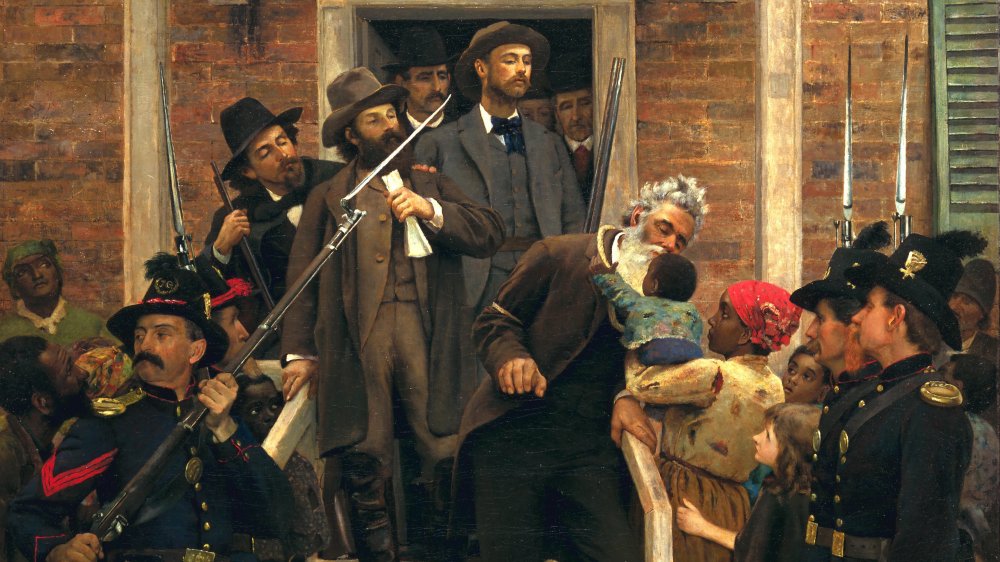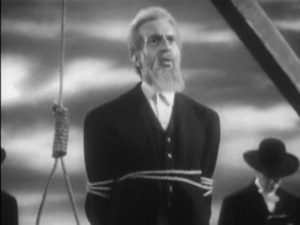
The exploits of John Brown have long fascinated historians. His actions, for better or worse, certainly had a significant effect on the country prior to Southern secession, but the fascination with Brown is largely driven by the enigma the man himself has proven to be. In trying to explain his actions and motives, historians have wrestled with questionable and biased testimonies by the people who knew him, and many of the mysteries surrounding John Brown have been explained – then and now – by mental disorders.
But was John Brown crazy? Diagnosing historical figures is an ambitious task, but the history of where the insanity claim for John Brown came from is insightful.
Psychiatry was evolving in the medical field in the beginning of the nineteenth century. For centuries, physicians in the western world acknowledged four basic psychological illnesses. The first was mania, which was exhibited through erratic behavior, irritability, and wild, racing thoughts. Second was melancholia, which was essentially depression. The third was dementia, defined much as it is today. And finally, there was delirium, which was characterized by hallucinations, delusions, and disorientation.
In 1838, Isaac Ray published his Treatise on the Medical Jurisprudence of Insanity. This work was used largely to aid psychiatric diagnoses for legal purposes. For mania, Ray offered sub-categories that sought to refine this classic form of madness. “Partial intellectual mania” described what was, at the time, commonly being referred to as “monomania.” Symptoms for monomania varied, describing cases that would likely be diagnosed by modern psychiatrists under various distinct labels. In one class of cases of monomania Ray wrote about, the disorder would breed “a train of morbid ideas,” with “one insane notion disappearing to give place to another and another.”
In a later section, Ray writes, “Though monomaniacs are generally ready enough to declare their predominant idea, yet when sufficient inducement exists, such as interests, fear of ridicule etc., they will occasionally conceal it.”

John Brown, 1859
Ray also devoted a chapter to what he termed “moral mania,” which included a subcategory of “partial moral mania.” Insanity, Ray noted, “often affects the moral, as it does the intellectual perceptions.” With partial moral mania, “the derangement is confined to one or a few of the affective faculties, the rest of the moral and intellectual constitution preserving its ordinary integrity.” When this manifested, the disorder compelled “the individual to action by a kind of instinctive irresistibility.” For “homicidal” or “instinctive monomania,” a person who appeared normal most of the time might remorselessly commit a violent crime, driven by “blind, irresistible impulse.”
Modern psychiatry has come a long way since Isaac Ray wrote his book, but this was the accepted science of John Brown’s day. With Ray’s treatise, the insanity defense became increasingly common, and many of Ray’s descriptions appeared to explain John Brown to his contemporaries – including, as Ray wrote, his “semblance of a perfectly rational man” projected “by carefully abstaining from the mention of his hallucinations.” Thus, the absence of any evidence regarding hallucinations (such as, as some people have believed, Brown being driven by the voice of God) was not enough to dismiss the insanity diagnosis by standards of the time.
Ray’s theory spread fast. The year it was published, David Meredith Reese, a physician in New York had already explicitly tied the diagnosis to abolitionism in a book titled Humbugs of New-York. “Fully persuaded that his motives are pure,” Reese wrote in a chapter on “Ultra-Abolitionism,” “. . . Such a monomaniac is prepared to labour, to suffer, or to die for his cause.” Much as John Brown would do two decades later, Reese claimed that a person suffering under this mania would “glory in martyrdom itself.”
John Brown’s Trial
When Brown was on trial for his act of treason (the official charge for which he was hanged), all sides had an interest in arguing John Brown’s mental instability, and the medical theories at the time supported their claims.
Brown’s supporters sought to present Brown as a monomaniac to prevent the death penalty, though these were the people who were least likely to legitimately believe him insane. His enemies wanted to present him as insane as a smear against all abolitionists – and many northerners would distance themselves from the abolitionist movement following Brown’s raid at Harper’s Ferry. Outside of those closest to Brown, most people probably genuinely believed he suffered from a monomania that manifested itself through his obsession with slavery.
Brown himself was the primary opponent to the insanity argument, believing that it would undermine his role as a martyr (one of Reese’s listed symptoms of ultra-abolitionist monomania). But an insane man’s denial of his insanity is hardly convincing to outside observers.
After Brown’s death, his mental instability was generally accepted. Historians looking back on these events, rather than questioning the insanity claims, tried to explain them. Allan Nevins, in the mid-twentieth century, believed Brown to have suffered from a psychosis, which he attributed to frustration Brown felt due to his many business failures throughout his life. Brown did suffer business failures, to be sure, but this explanation ignores the many years of happy success he also enjoyed. More importantly, Brown’s personal letters following these failures never demonstrated signs of mental distress over them; his pride in life appears to have been derived from God and family.
Other historians believed Brown to be a religious fanatic. This was certainly true in a loose sense, but not necessarily true as a genuine psychiatric disorder – if Brown did believe to have heard the direct voice of God, he never actually expressed this belief. He often argued that God was on his side, and he clearly viewed himself as an instrument of God’s will, but all of these statements appear to be assertions of faith, rather than the direct communication with God that many a cult leader has claimed. His fanaticism, then, can only explicitly be attributed to sincere faith, rather than diagnosable delusion.
Modern psychiatry offers more rigorous standards for diagnosing and classifying mental disorders. In a fairly recent piece of scholarship, historian Robert McGlone undertook a thorough examination of Brown’s writings and other records and analyzed Brown’s psychiatric state according to the modern fourth edition of the Diagnostic and Statistical Manual of Mental Disorders. It is, of course, impossible to definitively refute claims that Brown was mentally ill, but after his analysis, McGlone concludes, “If Brown suffered from mental illness or personality disorder, it eludes classification.”
A better psychological explanation, McGlone suggests, is offered by the social psychologist Albert Bandura. Following the Pottawattamie Massacre, in which Brown led a small band of men to hack five Kansas settlers to death with broadswords, Brown’s psychological state resembles not somebody who is necessarily mentally ill, but rather, somebody who has exhibited “mechanisms of moral disengagement.” Bandura, for his part, was concerned with twentieth-century terrorists when he identified six of these mechanisms that allow the terrorist to rationalize his actions.
First, the terrorist accepts his actions as being part of some religious creed or moral ideology. John Brown made explicit his religious motivation.
Second, he compares his acts to something more morally heinous. For John Brown, and many others at the time and since, slavery served this role.
Third, the terrorist deflects responsibility for his crime by viewing himself as simply an instrument. Whether due to unstated delusions or oft-proclaimed faith, Brown certainly viewed himself as the instrument of God.
Fourth, the terrorist blames his actions on third-party provocation, such as what we recognize as “blowback” from military strikes in other countries. In Kansas, the pro-slavery settlers provided this explicitly, and at Harper’s Ferry, the slaveholding South provided this implicitly.
Fifth, terrorists will disregard the consequences of their actions through selective inattention. John Brown, for example, never seem to acknowledge the irony of his men having killed a free black man at Harper’s Ferry (the first casualty of the raid), and he was entirely unconcerned with the prospect of blowback from Southerners against slaves they feared might revolt. As far as we can tell, such consequences never even occurred to him, before or after the raid.
Finally, a terrorist will dehumanize his victims. They might be “savage” or “satanic” — descriptors used by many abolitionists against slave owners — and as such, they will only respond to force.

Raymond Massey as John Brown, Santa Fe Trail, WB, 1940
Regardless of whether or not John Brown’s actions were justified — something people will probably never stop debating — the analysis of the psychology of the modern terrorist does appear to better explain John Brown’s actions, as Robert McGlone suggests. But these characteristics are not indicative of mental illness; they are simply part of the psychological analysis of the rationalization for certain behaviors. In simple terms, John Brown — if this analysis is correct — was guilty of selection bias; he simply ignored any evidence or arguments that were inconsistent with his settled beliefs.
When John Brown gave his final words, prior to being hanged, many observers were impressed with his cogency. If Brown was insane, people failed to recognize it in their interactions with him; he was clearly a man with an obsession, religious fanaticism, and grandiose ideas, and if Brown genuinely believed Harper’s Ferry would turn out as he claimed, he obviously miscalculated. But his sanity, at least clinically speaking, seems to have been in place.
